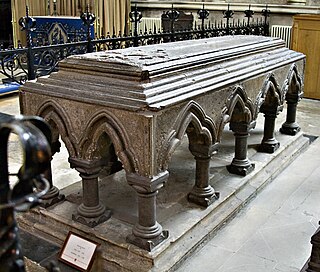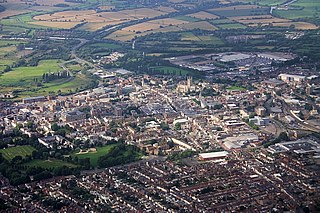Æthelnoth was a medieval Archbishop of Canterbury. Descended from an earlier English king, Æthelnoth became a monk prior to becoming archbishop. While archbishop, he travelled to Rome and brought back saint's relics. He consecrated a number of other bishops who came from outside his archdiocese, leading to some friction with other archbishops. Although he was regarded as a saint after his death, there is little evidence of his veneration or of a cult in Canterbury or elsewhere.

William Juxon was an English churchman, Bishop of London from 1633 to 1649 and Archbishop of Canterbury from 1660 until his death.

William Giffard (d. 23 January 1129, was the Lord Chancellor of England of William II and Henry I, from 1093 to 1101, and Bishop of Winchester.
William of York was an English priest and Archbishop of York. William has the unusual distinction of having been Archbishop of York twice, both before and after his rival Henry Murdac. He was thought to be a relative of King Stephen of England, and the king helped secure William's election to York after a number of candidates had failed to secure papal confirmation. William faced opposition from the Cistercians who, after the election of the Cistercian Pope Eugene III, managed to have the archbishop deposed in favour of the Cistercian Murdac. From 1147 until 1153, William worked to secure his restoration to York, which he finally achieved after the deaths of both Murdac and Eugene III. He did not retain the see long, as he died shortly after returning to York, allegedly having been poisoned. After William's death miracles were reported at his tomb from the year 1177 onwards, and in the year 1227 he was declared a saint.
Robert Bloet was Bishop of Lincoln 1093-1123 and Chancellor of England. Born into a noble Norman family, he became a royal clerk under King William I. Under William I's son and successor King William II, Bloet was first named chancellor then appointed to the See of Lincoln. Continuing to serve the king while bishop, Bloet remained a close royal councillor to William II's successor, King Henry I. He did much to embellish Lincoln Cathedral, and gave generously to his cathedral and other religious houses. He educated a number of noblemen, including illegitimate children of Henry I. He also was the patron of the medieval chronicler Henry of Huntingdon, and was an early patron of Gilbert of Sempringham, the founder of the Gilbertine monastic order.

Thomas of Bayeux was Archbishop of York from 1070 until 1100. He was educated at Liège and became a royal chaplain to Duke William of Normandy, who later became King William I of England. After the Norman Conquest, the king nominated Thomas to succeed Ealdred as Archbishop of York. After Thomas' election, Lanfranc, Archbishop of Canterbury, demanded an oath from Thomas to obey him and any future Archbishops of Canterbury; this was part of Lanfranc's claim that Canterbury was the primary bishopric, and its holder the head of the English Church. Thomas countered that York had never made such an oath. As a result, Lanfranc refused to consecrate him. The King eventually persuaded Thomas to submit, but Thomas and Lanfranc continued to clash over ecclesiastical issues, including the primacy of Canterbury, which dioceses belonged to the province of York, and the question of how York's obedience to Canterbury would be expressed.
Æthelgar was Archbishop of Canterbury, and previously Bishop of Selsey.

Oswald of Worcester was Archbishop of York from 972 to his death in 992. He was of Danish ancestry, but brought up by his uncle, Oda, who sent him to France to the abbey of Fleury to become a monk. After a number of years at Fleury, Oswald returned to England at the request of his uncle, who died before Oswald returned. With his uncle's death, Oswald needed a patron and turned to another kinsman, Oskytel, who had recently become Archbishop of York. His activity for Oskytel attracted the notice of Archbishop Dunstan who had Oswald consecrated as Bishop of Worcester in 961. In 972, Oswald was promoted to the see of York, although he continued to hold Worcester also.
Richard Courtenay was an English prelate and university chancellor.

Oscytel was a medieval Bishop of Dorchester and Archbishop of York.

Cynesige was a medieval English Archbishop of York between 1051 and 1060. Prior to his appointment to York, he was a royal clerk and perhaps a monk at Peterborough. As archbishop, he built and adorned his cathedral as well as other churches, and was active in consecrating bishops. After his death in 1060, the bequests he had made to a monastery were confiscated by the queen.

Sewal de Bovil was a medieval Archbishop of York.
William de Wickwane was Archbishop of York, between the years 1279 and 1285.
Henry of Newark was a medieval Archbishop of York.

William Zouche or William de la Zouche (1299–1352) was a medieval Lord Treasurer of England, and Archbishop of York from 1342 to 1352.
Guala Bicchieri was an Italian diplomat, papal official and cardinal. He was the papal legate in England from 1216 to 1218, and took a prominent role in the politics of England during King John’s last years and Henry III’s early minority.

Hilary (c. 1110–1169) was a medieval Bishop of Chichester in England. English by birth, he studied canon law and worked in Rome as a papal clerk. During his time there, he became acquainted with a number of ecclesiastics, including the future Pope Adrian IV, and the writer John of Salisbury. In England, he served as a clerk for Henry of Blois, who was the Bishop of Winchester and brother of King Stephen of England. After Hilary's unsuccessful nomination to become Archbishop of York, Pope Eugene III compensated him by promoting him to the bishopric of Chichester in 1147.
Henry Marshal was a medieval Bishop of Exeter.
William Hamilton was deputy chancellor of England from 1286 to 1289, then Lord Chancellor from 1305 to his death on 20 April 1307. He was also Dean of York.
Roger of London was an English Benedictine monk and abbot of Selby Abbey from 1189 to 1195.










